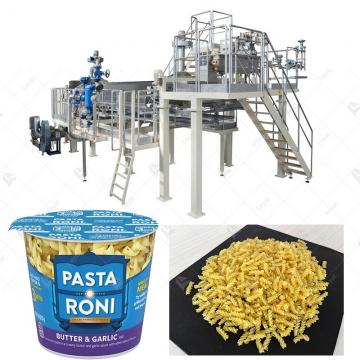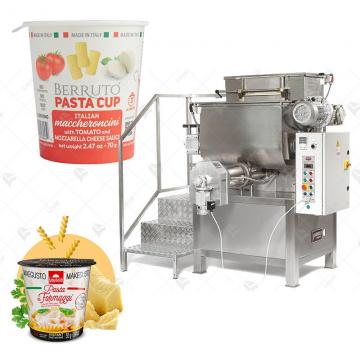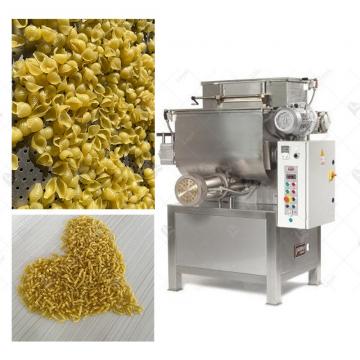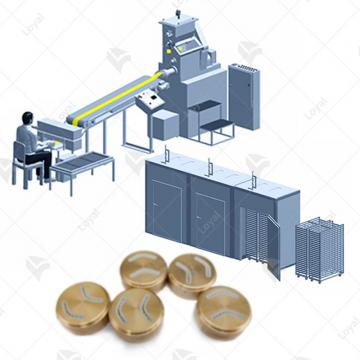
- Shandong Loyal Industrial Co.,Ltd.
- SHORT-CUT PASTA PRODUCTION LINE LONG-CUT PASTA PRODUCTION LINE INSTANT PASTA PRODUCTION LINE
Home> Company News> The Ultimate Guide to Instant Pasta Production Line in 2024

The Ultimate Guide to Instant Pasta Production Line in 2024
2024-03-28 12:21:33An instant pasta production line is a sophisticated assembly of machinery designed to streamline the manufacturing process of instant pasta products. It encompasses various stages, from dough preparation to packaging, with the aim of producing high-quality instant pasta efficiently and consistently. These production lines are equipped with cutting-edge technology to ensure precision and speed, catering to the ever-growing demand for quick meal solutions.
Importance of Instant Pasta Production Lines in the Food Industry
Instant pasta production lines play a pivotal role in meeting consumer preferences for convenient and time-saving meal options. With hectic lifestyles becoming the norm, consumers increasingly gravitate towards instant pasta products that offer the perfect balance of taste, nutrition, and convenience. These production lines enable manufacturers to meet this demand effectively while maintaining the highest standards of quality and efficiency.
Moreover, instant pasta production lines contribute to the diversification of product offerings in the food industry. They empower manufacturers to explore a wide range of flavors, shapes, and packaging formats, catering to diverse consumer preferences. Whether it's classic spaghetti or innovative pasta cups, these production lines offer versatility and adaptability to meet evolving market trends.
In addition to meeting consumer demands, instant pasta production lines also offer economic benefits for manufacturers. By optimizing the production process and minimizing waste, these lines enhance operational efficiency and reduce production costs. This translates to higher profitability and competitive pricing for instant pasta products in the market.
Components of an Instant Pasta Production Line
1. Mixing and Kneading Machines
At the heart of any instant pasta production line lies the mixing and kneading machines, where the magic of pasta dough begins. These machines are equipped with state-of-the-art technology to precisely blend the ingredients, ensuring the perfect consistency and texture of the dough. With meticulous control over factors such as hydration and temperature, these machines lay the foundation for the entire production process.
2. Extruders
Once the dough reaches optimal consistency, it is fed into the extruders – the workhorses of the production line. These robust machines shape the dough into various pasta forms with incredible precision and speed. From spaghetti to penne, extruders can produce a diverse range of pasta shapes, meeting the diverse preferences of consumers worldwide.
3. Drying Units
After shaping, the freshly extruded pasta undergoes a crucial phase in the drying units. Here, controlled airflow and temperature ensure uniform drying, preserving the pasta's integrity while eliminating excess moisture. The drying process is meticulously monitored to achieve the ideal balance between moisture content and shelf stability, guaranteeing a premium-quality end product.
4. Packaging Machinery
Once dried to perfection, the pasta is ready for packaging – a task efficiently handled by advanced packaging machinery. These automated systems can handle various packaging formats, from traditional boxes to innovative pouches. With precise weighing and sealing capabilities, they ensure the freshness and integrity of the pasta throughout its shelf life, ready to delight consumers at a moment's notice.
5. Quality Control Systems
At every stage of the production line, stringent quality control measures are in place to uphold the highest standards of excellence. Advanced sensors and monitoring devices detect any deviations from specifications, allowing for immediate adjustments and interventions. From dough consistency to final packaging, every aspect of the process undergoes rigorous scrutiny to deliver instant pasta products that surpass expectations.
Processes Involved in Instant Pasta Production
1. Ingredient Preparation and Mixing
The journey of instant pasta begins with meticulous ingredient preparation and mixing. Precooked pasta production line initiates this process by precisely measuring and blending key ingredients such as durum wheat flour, water, and sometimes eggs. This mixture undergoes thorough homogenization to achieve a consistent texture and flavor profile, ensuring uniformity across each batch.
2. Extrusion and Shaping
Once the ingredients are perfectly mixed, the next phase involves extrusion and shaping, a critical step facilitated by the instant pasta production line. The mixed dough is fed into the extruder, where it undergoes high pressure and temperature to form the desired pasta shapes. Advanced machinery allows for versatile shaping options, ranging from classic spaghetti to intricate fusilli, catering to diverse consumer preferences.
3. Drying Methods and Techniques
Drying is paramount in instant pasta production as it enhances shelf stability and preserves the pasta's quality. Modern precooked pasta production lines incorporate advanced drying methods such as hot air drying or microwave drying, expediting the process while maintaining nutritional integrity. Through precise temperature and humidity control, these systems ensure optimal drying conditions, resulting in perfectly cooked pasta upon rehydration.
4. Packaging and Sealing
Efficient packaging is indispensable in preserving the freshness and flavor of instant pasta products. The instant pasta cup production line excels in this aspect, offering convenient single-serve packaging solutions. Once the pasta is dried to perfection, it is carefully portioned into individual cups and sealed to prevent moisture ingress. This packaging not only enhances convenience for consumers but also extends the product's shelf life, making it ideal for on-the-go consumption.
5. Quality Assurance and Testing
Throughout the entire production process, stringent quality assurance measures are implemented to uphold product excellence. Cutting-edge technologies integrated into precooked pasta production lines and instant pasta production lines enable real-time monitoring of key parameters such as texture, moisture content, and microbiological safety. Comprehensive testing protocols ensure compliance with regulatory standards, guaranteeing that each batch of instant pasta meets the highest quality benchmarks.
Application of Instant Pasta Production Line
Application of Instant Pasta Production Line transcends traditional boundaries, revolutionizing the food industry landscape. From bustling urban centers to remote countryside retreats, the convenience of instant pasta has captivated consumers across the globe. Whether it's a quick lunchtime fix or a savory midnight snack, the versatility of instant pasta knows no bounds.
In commercial kitchens, the instant pasta production line serves as a beacon of efficiency, streamlining operations and maximizing output. Chefs and restaurateurs can harness the power of this technology to expedite meal preparation without compromising on quality. From fast-food establishments to upscale eateries, the incorporation of instant pasta technology has become synonymous with culinary innovation.
Beyond the realm of consumer convenience, the instant pasta production line holds immense potential for humanitarian aid efforts. In disaster-stricken areas or impoverished communities, access to nutritious meals is often limited. By deploying instant pasta ready-meal production line technology, relief organizations can swiftly distribute sustenance to those in need, providing nourishment and comfort during times of crisis.
As we navigate the culinary landscape of 2024, the instant pasta production line stands as a testament to ingenuity and progress. With its seamless integration of technology and tradition, this innovative solution has redefined the concept of convenience in the realm of food production. From manufacturing facilities to dining tables, the impact of instant pasta technology reverberates far and wide, shaping the way we eat and experience food in the modern age.
Routine Maintenance of Routine Maintenance of Instant Pasta Production Line
An instant pasta cup production line comprises various machines and systems working seamlessly together to produce ready-to-eat pasta meals efficiently. These lines typically include a cup pasta making machine which forms the cups, a filling machine for the pasta, sauces, and condiments, a sealing machine, and a packaging unit.Routine maintenance of an instant pasta cup production line involves inspecting and servicing each component regularly. This ensures that the machines operate at their optimal capacity, reducing downtime and enhancing productivity.
1. Cleaning: Regular cleaning of the machines is essential to prevent the accumulation of food particles and debris, which can lead to contamination and equipment damage. Use approved cleaning agents and follow manufacturer guidelines for proper sanitation.
2. Lubrication: Proper lubrication of moving parts reduces friction and wear, extending the lifespan of the equipment. Lubricate bearings, gears, and other moving components according to the manufacturer's recommendations.
3. Inspection: Conduct thorough inspections of all components to identify any signs of wear or damage. Replace worn-out parts promptly to prevent equipment failure during operation.
4. Calibration: Ensure that the machines are calibrated correctly to maintain product consistency and quality. Check temperature, pressure, and other parameters regularly and recalibrate as necessary.
5. Training: Provide training to maintenance personnel to ensure they understand the importance of routine maintenance and follow proper procedures. Encourage a proactive approach to identify and address potential issues before they escalate.
Factors Affecting Instant Pasta Production Line Efficiency
In the realm of food manufacturing, the efficiency of instant pasta production lines plays a critical role in meeting consumer demand while maintaining quality standards. Several factors contribute to the efficiency of these production lines, each playing a crucial role in the overall process. Let's delve into the discussion on these factors:
1.Ingredient Quality and Consistency
Instant pasta cup production line performance heavily relies on the quality and consistency of ingredients. The raw materials used in pasta manufacturing, such as flour, water, and additives, must meet strict quality standards to ensure optimal production outcomes. Inconsistent ingredient quality can lead to variations in the final product, affecting taste, texture, and shelf life.
Maintaining a reliable supply chain for high-quality ingredients is essential. Regular quality checks and testing protocols should be in place to identify any deviations and address them promptly. By prioritizing ingredient quality, instant pasta line operators can enhance production efficiency and deliver consistent products to consumers.
2.Equipment Maintenance and Calibration
Effective maintenance and calibration of instant pasta ready-meal production line equipment are paramount for sustained efficiency. Over time, wear and tear can occur, leading to decreased performance and potential breakdowns. Regular maintenance schedules and proactive repairs are necessary to prevent costly downtime and ensure smooth operations.
Calibration of equipment, including mixers, extruders, and packaging machines, is crucial for maintaining product consistency and quality. Any deviations in machine settings can impact the final product, leading to variations that may not meet consumer expectations. By implementing stringent maintenance and calibration procedures, cup pasta making machine operators can optimize production efficiency and minimize disruptions.
3.Production Line Layout and Design
The layout and design of the instant pasta production line significantly influence its efficiency. A well-designed layout streamlines the flow of materials and processes, minimizing unnecessary movement and reducing production time. Factors such as the arrangement of equipment, conveyor belts, and workstation ergonomics play a vital role in maximizing efficiency.
Efficient use of space and resources is key to optimizing production line performance. By carefully planning the layout and considering factors such as workflow, safety, and accessibility, manufacturers can enhance productivity and minimize waste. Continuous evaluation and improvement of the production line layout ensure adaptability to changing demand and market trends.
4.Automation and Technology Integration
Automation and technology integration are driving forces behind the efficiency of instant pasta lines. Automated systems streamline processes, reduce labor costs, and improve overall productivity. From automated ingredient dispensing systems to robotic packaging solutions, advanced technologies play a crucial role in modern pasta manufacturing.
Integration of cutting-edge technologies such as artificial intelligence and data analytics enables real-time monitoring and optimization of production processes. Predictive maintenance algorithms can identify potential equipment failures before they occur, minimizing downtime and maximizing uptime. By embracing automation and technology, instant pasta line operators can stay competitive in today's fast-paced market landscape.
Trends and Innovations in Instant Pasta Production
In recent years, the instant pasta production industry has witnessed significant advancements and innovations to meet the evolving demands of consumers. From the integration of cutting-edge materials in equipment construction to the implementation of automation and robotics for enhanced efficiency, the sector is experiencing a transformative phase. Let's explore five key trends and innovations driving the instant pasta production landscape:
The instant pasta cup production line is leveraging the latest advancements in materials science to enhance durability, efficiency, and hygiene standards. Stainless steel alloys, renowned for their corrosion resistance and longevity, are increasingly prevalent in the fabrication of processing equipment. Components such as mixing tanks, extruders, and packaging machinery are engineered using high-grade materials to withstand the rigorous demands of mass production.
Automation plays a pivotal role in streamlining operations and optimizing productivity in the instant pasta ready-meal production line. From ingredient handling and dough preparation to cooking and packaging, automated systems ensure precision and consistency at every stage of the manufacturing process. Robotic arms equipped with AI-enabled vision systems facilitate intricate tasks such as pasta shaping and portioning, enabling manufacturers to meet stringent quality standards while boosting throughput.
In response to growing environmental concerns, the instant pasta industry is embracing sustainable packaging solutions to minimize its ecological footprint. Manufacturers are transitioning towards recyclable and biodegradable materials for cup pasta making machine packaging, reducing reliance on conventional plastics. Innovations such as compostable cups and eco-friendly films are gaining traction, aligning with consumer preferences for environmentally responsible products.
With consumers increasingly seeking personalized food experiences, the instant pasta sector is introducing customizable options to cater to diverse tastes and preferences. Instant pasta line manufacturers are offering a variety of flavor profiles, ingredient combinations, and portion sizes to accommodate individual dietary requirements and culinary preferences. Advanced production technologies enable on-demand manufacturing, allowing consumers to tailor their pasta meals according to specific preferences, from spicy arrabbiata to creamy alfredo.
Ensuring food safety and quality is paramount in the instant pasta production industry, prompting continuous advancements in sanitation and hygiene protocols. Instant pasta cup production line manufacturers are implementing state-of-the-art sanitation systems, including automated cleaning-in-place (CIP) systems and ultraviolet (UV) disinfection technology, to eliminate microbial contaminants and maintain product integrity. Strict adherence to regulatory standards and frequent quality inspections further reinforce the commitment to food safety.
Challenges and Solutions in Instant Pasta Production
One of the key challenges in instant pasta production is maintaining consistent product quality. Variations in ingredients, processing conditions, and equipment performance can lead to differences in taste, texture, and appearance. To address this challenge, manufacturers invest in advanced instant pasta line technology equipped with precise controls and monitoring systems.
The instant pasta line utilizes state-of-the-art equipment such as cup pasta making machines to ensure uniformity in portion sizes and cooking times. By automating the production process, manufacturers can minimize human error and achieve greater consistency in product quality. Additionally, rigorous quality control procedures, including sensory evaluation and laboratory testing, are implemented to detect any deviations from the desired standards.
Another challenge faced by instant pasta manufacturers is effectively managing production costs and minimizing waste. Ingredients such as flour, water, and seasoning represent significant expenses, and any inefficiencies in the production process can lead to increased costs and reduced profitability. Moreover, excessive waste generation not only impacts the bottom line but also raises environmental concerns.
To address these challenges, manufacturers employ instant pasta cup production lines optimized for efficiency and sustainability. These production lines are designed to minimize raw material usage, energy consumption, and waste generation while maximizing throughput and yield. Additionally, advanced process control algorithms and predictive maintenance systems help optimize equipment performance and reduce downtime.
Consumer preferences and market trends are constantly evolving, posing a challenge for instant pasta manufacturers to stay relevant and competitive. Shifts in dietary habits, flavor preferences, and packaging preferences require quick adaptation to meet changing demand.
To address this challenge, manufacturers invest in research and development to innovate new instant pasta products and flavors that cater to diverse consumer tastes. Furthermore, flexibility in production processes, such as the ability to rapidly switch between product variants and packaging formats, is essential for responding to market demands.
Instant Pasta Cup Production Line: Meeting Regulatory Standards
In the realm of food production, the instant pasta cup production line stands out as a marvel of efficiency and convenience. This innovative system allows for the rapid production of ready-to-eat pasta meals, meeting the demands of busy consumers worldwide. Let's delve into the intricate workings of the instant pasta ready-meal production line and explore the regulatory considerations and compliance measures that govern its operation.
At the heart of instant pasta line operations lies a commitment to food safety and quality. This dedication is reflected in the stringent adherence to food safety regulations set forth by governing bodies worldwide. From the sourcing of ingredients to the final packaging stage, every aspect of production is meticulously monitored and controlled.
The cup pasta making machine is equipped with state-of-the-art technology designed to maintain hygienic conditions throughout the manufacturing process. Automated systems precisely measure and mix ingredients, minimizing the risk of contamination. Moreover, robust quality control protocols are in place to detect and eliminate any potential hazards before the products reach consumers.
In accordance with regulatory standards, regular inspections and audits are conducted to ensure compliance with food safety guidelines. These measures not only safeguard consumer health but also uphold the reputation of brands operating within the instant pasta industry.
Beyond ensuring food safety, instant pasta manufacturers must also comply with packaging and labeling requirements. Packaging materials must be selected carefully to preserve the freshness and integrity of the products while minimizing environmental impact.
Labels play a crucial role in providing consumers with essential information about the instant pasta products. From nutritional content to allergen warnings, every detail must be clearly communicated to enable informed purchasing decisions. Additionally, accurate labeling helps prevent misrepresentation and promotes transparency in the marketplace.
Innovations in packaging technology, such as eco-friendly materials and intelligent designs, are driving sustainability initiatives within the instant pasta industry. By reducing waste and environmental footprint, manufacturers can align with evolving regulatory expectations and consumer preferences.
Environmental Regulations and Sustainability Initiatives: Promoting Responsible Practices
In an era marked by growing environmental awareness, instant pasta producers are embracing sustainability initiatives to minimize their ecological footprint. From energy-efficient manufacturing processes to recyclable packaging options, every effort is made to reduce environmental impact.
Compliance with environmental regulations is paramount in ensuring the long-term viability of instant pasta production. By adhering to waste management protocols and emission standards, manufacturers contribute to a healthier planet while maintaining regulatory compliance.
Furthermore, sustainability initiatives not only benefit the environment but also resonate with eco-conscious consumers. Brands that prioritize environmental stewardship can enhance their reputation and appeal to a growing segment of socially responsible consumers.
Future Outlook for Instant Pasta Production
Instant pasta production is experiencing a significant transformation with the introduction of advanced technologies. The future outlook for this industry is promising, with emerging technologies such as the instant pasta cup production line, instant pasta ready-meal production line, instant pasta line, and cup pasta making machine paving the way for innovation and efficiency.
The integration of automated systems and robotics in instant pasta production lines is revolutionizing the way pasta is manufactured. These technologies streamline processes, reduce labor costs, and enhance overall productivity. For instance, the instant pasta line incorporates state-of-the-art machinery capable of producing a wide variety of pasta shapes and sizes with precision and speed. The cup pasta making machine automates the packaging process, ensuring consistent portion sizes and packaging quality.
The market for instant pasta products is projected to experience significant growth in the coming years, driven by changing consumer lifestyles and preferences. Busy schedules and the demand for convenient meal solutions contribute to the increasing popularity of instant pasta products. With the introduction of innovative production lines, manufacturers have the opportunity to capitalize on this growing market segment and expand their product offerings.
Despite the promising outlook, the instant pasta production industry faces challenges that require innovative solutions. One such challenge is meeting consumer demand for healthier and more nutritious options. Manufacturers must explore the use of alternative ingredients and improve the nutritional profile of their products to align with consumer preferences.Additionally, sustainability concerns continue to be a key focus in the food industry. Instant pasta production lines need to adopt eco-friendly practices and packaging solutions to minimize environmental impact. This includes reducing waste, optimizing energy consumption, and sourcing ingredients responsibly.
Innovation and development in instant pasta production will also focus on enhancing product quality and taste. Consumers expect instant pasta products to offer the same level of flavor and texture as traditional pasta dishes. Therefore, research and development efforts will be directed towards improving cooking methods, ingredient formulations, and flavor profiles.
References
1.Pasta Extrusion Technology:
Website: https://www.pastaextrusion.com/
- American Association of Cereal Chemists International (AACCI):
Website: https://www.aaccnet.org/
- European Federation for Food Science and Technology (EFFoST):
Website: https://www.effost.org/
- Italian Association of Pasta Industries (AIDEPI):
Website: http://www.aidepi.it/
- Food and Agriculture Organization of the United Nations (FAO)
Website: http://www.fao.org/
FAQs: Frequently Asked Questions about Instant Pasta Production Line
1. What are the key components of an instant pasta production line?
An instant pasta production line typically consists of dough mixing machines, extruders, cutters, dryers, and packaging equipment.
2. How does an instant pasta production line ensure product quality?
Instant pasta production lines are equipped with advanced technology for precise control of ingredients, cooking, and packaging, ensuring consistency and quality in every batch.
3. Can instant pasta production lines accommodate different types of pasta?
Yes, modern instant pasta production lines are highly versatile and can produce various pasta shapes, sizes, and textures to cater to diverse consumer preferences.
4. Are instant pasta products manufactured using these production lines nutritious?
Instant pasta products manufactured using quality ingredients and advanced production techniques can offer nutritional value comparable to traditional pasta.
5. What is the shelf life of instant pasta products produced by these lines?
Instant pasta products are typically designed for extended shelf life, ranging from several months to over a year, depending on packaging and storage conditions.
 Instant Pasta Production Line
Instant Pasta Production Line INSTANT PASTA CUP PRODUCTION LINE
INSTANT PASTA CUP PRODUCTION LINE PRECOOKED PASTA PRODUCTION LINE
PRECOOKED PASTA PRODUCTION LINE Dry Pasta Production Line
Dry Pasta Production Line